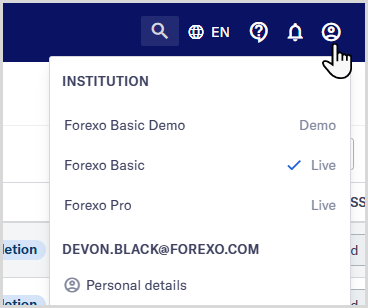Testing Maxsight
When you're implementing a new configuration of Maxsight, you want to be sure it's working as expected.
We recommend running initial tests in your demo institution, a special environment just for testing. It does not run live checks, with the exception of checks run with free data providers, for example, Companies House.
You can view your current institution and switch to your Demo institution from the header bar.

When you're happy with how the demo institution works, you have the option to set up a staging institution. A staging institution is used for testing checks run by data providers with whom you have direct agreements. To request a staging institution, speak to the Client Service team.
Finally, we'll move everything over to your live production institution. This is the institution that your users will eventually see. Before you roll out Maxsight to your users, we recommend running tests in your live production institution to ensure your data providers and integrations are properly configured.
If you have any questions you can contact our Client Service team at clientservices@moodys.com.
Demo institution testing
The demo institution is designed to let your core development and testing teams run as many tests as they like.
The demo institution does not run live checks with any data providers that may charge you, so you can run checks without worrying about being charged.
All performance and load testing requires written permission; contact clientservices@moodys.com.
Default smart policy testing
When you get a Maxsight demo institution, we'll add a default smart policy to it.
You can use the default smart policy to start testing immediately, try out different policy behaviors, and get an idea of what changes we can make so your smart policy fits with your compliance procedures.
Workflow and risk level testing
Once you have your own smart policy, ideally, you want to test every path in your smart policy workflows that your assessments can follow. Find out what happens when assessments pass automatically and what happens when manual intervention is required.
To force entities down certain paths in an assessment workflow, create them with details that you know are critical to your workflow, such as nationality, pledge amount, and so on.
If you're using risk, you should also test onboarding with different risk levels.
As with workflow testing, you can force assessments to be assigned specific risk levels by creating entities with details relevant to your risk models.
Testing checks
The demo institution does not run live checks with any data providers that may charge you. Instead, all paid checks are simulated, and demo data is returned so you can see a sample of the results.
Maxsight provides a series of tests you can run to simulate check results with paid providers. To get the tests:
Find the instructions for your data providers.
Then, go to the section called . All the steps to run the tests are there.
You can combine test words into a single entity.
Some tests can return different results based on your configuration options.
You can also combine these tests with tests of your workflows and risk levels by giving the entities details that are critical to your workflows and risk models, such as nationality, pledge amount, and so on.
Live checks do run directly with data providers, such as Companies House; you can test with real data, and real results are returned.
API integration testing
When testing your API integration, you should confirm that:
When entities are created via the API, all required data populates in Maxsight correctly, including collected data and custom fields.
Webhook data is being returned as expected.
We recommend using aliases rather than IDs for your API calls when possible. Aliases will be the same in your demo institution and production institution, so you won't have to update your code when you switch institutions.
For more information about the API, see the Get started section for developers and the full API reference.
Staging institution testing
A staging institution is an optional transitional institution between your demo and production institutions.
Its purpose is to let you do rigorous end-to-end testing with your data providers with whom you have direct agreements.
Any data providers you have a direct agreement with will run live checks. You will be charged for these checks.
Caution
Before running any live checks on a real person, you must get their permission. Note that some checks, such as the Electronic identity check, run a soft credit check and may appear on the person's credit report.
Live institution testing
Your production institution is configured exactly the same as your demo institution and, if used, staging institution, but all checks are live.
You'll see real check results from your data providers, and you'll be charged for any checks you run.
You'll have likely completed the majority of your functional testing, such as the different routes through your risk model and smart policy workflows, in the demo institution, so we recommend using the live institution to test:
Whether the data providers are properly configured.
Whether all systems, including any customer systems, are properly integrated.
We recommend choosing a small subset of individuals to test on, for example, employees or family members.
Caution
Before running any live checks on a real person, you must get their permission. Note that some checks, such as the Electronic identity check, run a soft credit check and may appear on the person's credit report.
To complete the configuration for your live institution, we'll need the details for any direct agreements you have with your data providers. To find out what information we require, locate the information for your data providers and go to the section .